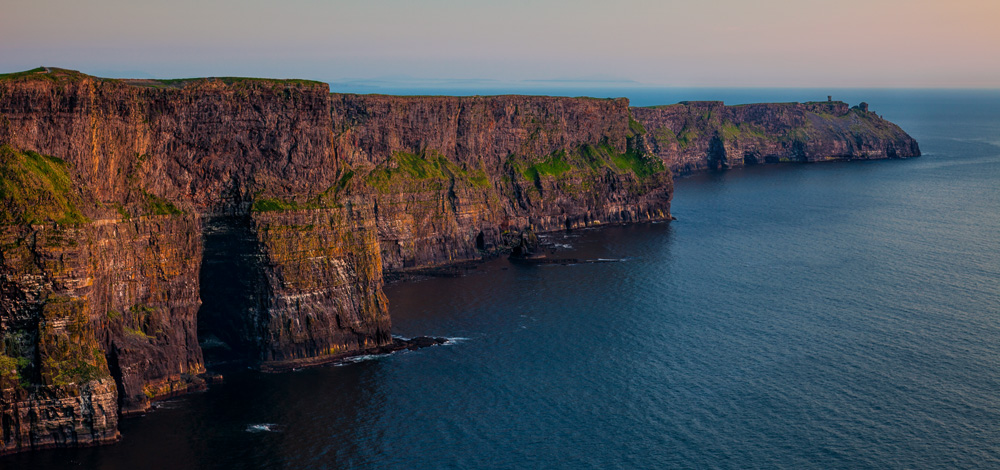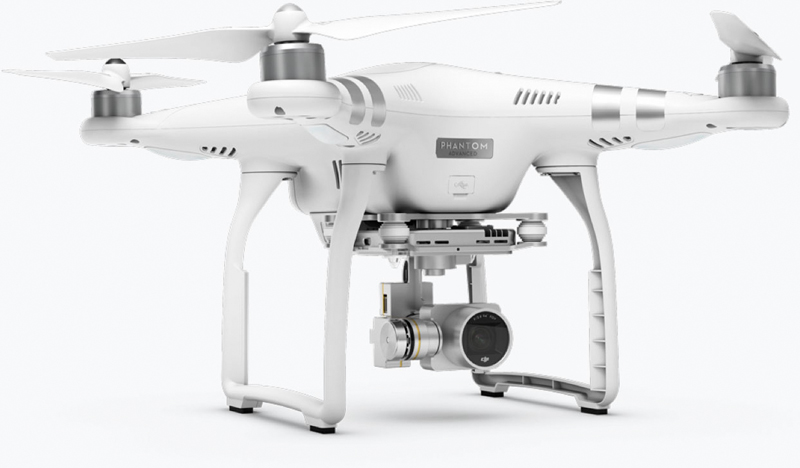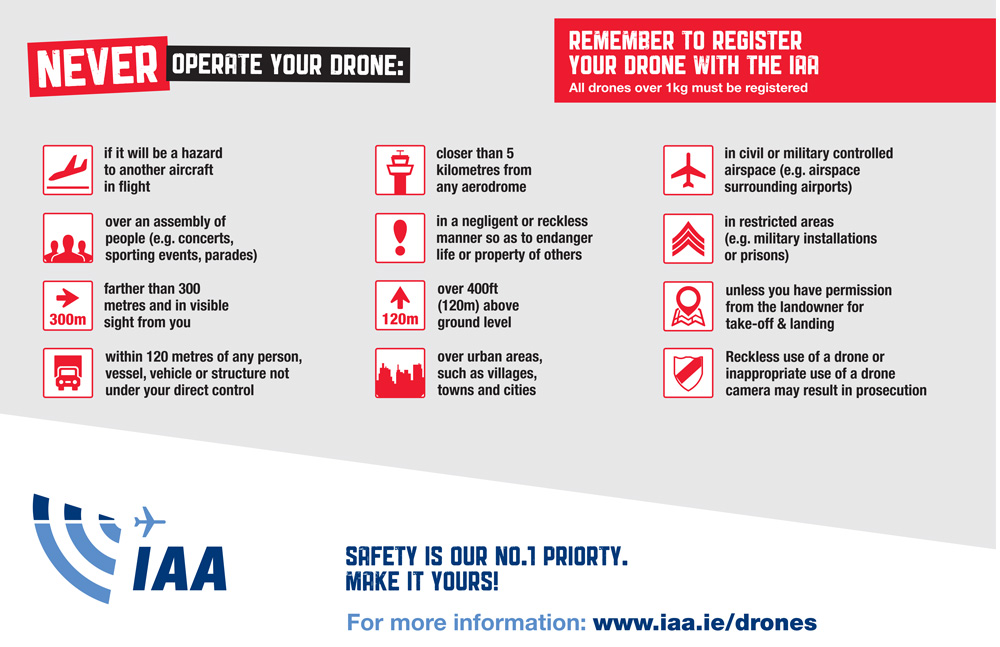A Basic, Non-Geeky Intro to Using Drones for your Photography

Until very recently, I was utterly uninterested in drones. It seemed like they were designed for those into aerial photography or shooting video (and I do neither). It also seemed like they were largely another way for people that like flying model airplanes to do so. I was actually sort of tired of hearing about them.
However, I am planning a trip to Ireland later this year and, having been there a few times, I realized that a drone would be hugely helpful to me on that trip. I will be spending a lot of time on cliffs and seacoasts wondering how to shoot back at the coast (rather than out into the ocean). There will also be a lot of places I just won’t be able to get to. A drone would be able to get a lot of shots I want and would open up a lot of different angles and perspectives.
But, I wondered, is buying a drone even remotely feasible? What do they cost? Could I fly one? Would I crash it into the cliffs? Would it include a decent camera (or support one)? And are there restrictions to their use that would hamper me? I knew the answer to not one of these questions.
But now I do. I spent the last week researching them and buying my first drone (a Phantom 3 Advanced by DJI). I’ve actually become quite excited about the possibilities.
It occurs to me that you might be in a similar spot as me and be wondering what these drones are all about. So I thought I’d put together an article on the basic questions you might have.
How Much Do These Things Cost?
The obvious first question is “what do these things cost?” There is no point in even thinking about them too much if they are prohibitively expensive.
For the answer to that question, unfortunately, I’m forced to start with the old “they cost as much or as little as you want to spend.” You can get one for $30 or you can spend thousands of dollars.
Ok, I understand that is pretty unhelpful, so let’s see if we can flesh it out a little. There are basically three categories of pricing for drones. I break them down like this:
- Beginner/Intro Level ($50 – $300): You can get a drone for very little money, but they are essentially toys. Many of them are miniature and those that have cameras won’t be able to capture high quality images. The video will be sub-HD. They are unsuitable if you are at all serious about photography. They are good for beginners looking to stick their toe in the water though. Here is a listing of beginner drones available at B&H.
- Prosumer or Intermediate Level ($500 – $1,250): In this range, you will find very capable drones, which are usually quadcopters (so named because they have 4 propellers). Those that do not have cameras are designed to carry a GoPro. Those that have built-in cameras will have image quality roughly equivalent to what you would get in the GoPro. That is, you will get very high video quality but mediocre at best still photo quality. Here is a list of intermediate or prosumer drones available at B&H.
- Pro Level ($2,000 – $4,500): These drones will typically be big, heavy, and will not include a built-in camera. Instead, they are designed to carry a DSLR or mirrorless camera. That’s great news for image quality, but bad news in that you have to add the price of the camera to the cost. Most of them will have 5 or 8 propellers. Here is the list of available models in this category from B&H.
These pricing levels are my own construct, and there is no magic to the ranges. It is just how I find things break down.
I imagine that you will probably be interested in drones at the prosumer or intermediate level. The Beginner level is really unsuited for photography, so you probably won’t want one of those. The top level is very expensive and probably not where you will want to start out. That leaves the intermediate level as your likely starting point, so let’s talk about that for a moment.
The prosumer/intermediate level is dominated by a company called DJI and its current model of drone called the Phantom 3. The Phantom 3 comes in three different versions: the Standard, the Advanced, and the Professional levels. I’m going to talk about these versions because they cover the range of intermediate choices pretty well, and also because they seem to be the industry standard at the moment. Of course, there are other models out there that are quite good as well, and it is not my intent to push you towards the Phantom, but it is a good way to introduce you to this level of drone. Here is the deal with each of these versions of the Phantom 3:
- Standard: The Standard version is a very capable drone that costs about $500. It will fly for about 25 minutes on a charge (as will all three models). It has a maximum distances of about 1000 meters. The camera takes 12MP pictures and shoots 2.7K video.
- Advanced: The Advanced version, which costs $800, allows you to fly further away with better controls. Whereas the Standard version has a maximum distance of 1000m, the Advanced version allows you to fly to to 5000m away. Further, the video transmits via Lightbridge (as opposed to Wifi for the Standard), which is a much better connection. In most other respects, this drone is the same as the Standard version. The camera is basically the same (more about the camera below).
- Professional: The Professional level costs $1,250 and gets you 4K video. Otherwise, it is pretty much the same as the Advanced version in that the drone has upgraded controls and flies further away.
Which one is best for you? Of course, that depends what you will be doing with it. I ended up going with the Advanced version because I was concerned about being limited by distance when I’m in Ireland. That might not be as much of an issue for you, which would mean that the Standard version would be a good place to start.

Before leaving this topic, I should mention also that DJI just came out with a new version called the Phantom 3 4K. It is basically the Standard model, but with a 4K camera on it. It costs $800 like the Advanced model. If you prize 4K video but have no need to send your drone any great distance, this might be a good model for you.
Are Drones Difficult to Fly?
Nope. They are remarkably easy.
Here is the key: when you are not doing anything, the drone hovers in the air on its own. If you stop all controls, the drone will sit in the air harmlessly. It doesn’t fall to the earth or fly forward on its own, thereby avoiding a lot of problems and the need for quick reactions.
Further, they have “return home” buttons or switches on them, so you can bring your drone home safely with ease.
To show you how easy it is to fly a drone, I will soon be posting a video showing you how to fly one. In the meantime here is a video from the manufacturer of the model I bought showing you how to fly one:
https://youtu.be/HoTdK7izUAA
All that said, be careful. When you are getting started, fly in an open area. Take some time to get used to the controls. Avoid flying in high winds. There are many examples of YouTube of drones being crashed or lost. Speaking of drone crashes, here is a nice compilation video of some:
What Kind of Cameras Do Drones Use/Support?
The cameras in the current drones are remarkably lackluster. That was something of a disappointment to me. The cameras in the Prosumer/Intermediate level are basically compact/point and shoot cameras. Specifically, they all have 1/2.3″ sensors (small digital sensors used in compact cameras) with a resolution of 12 megapixels.
I haven’t tested the camera yet, but I don’t need to to know that it is going to have serious limitations. With a sensor that small, low-light performance and dynamic range will both be issues. The good news, however, is that you will always be flying during the daylight hours so there will be plenty of light. That means you can keep your ISO low and avoid problems with digital noise. In addition, much of the time you will be shooting down toward the ground, so the sky won’t present a dynamic range challenge for you. Therefore, while the quality of these cameras is quite disappointing, it appears that the limitations of these cameras won’t hamper you as much as they might in other contexts.
What About the Lens?
No matter which model you get, the lenses on drones are very basic. The lens on your drone will be of one specific focal length (no zoom), which is usually between 14 and 20 mm. Some lenses will have a certain amount of “fisheye” distortion and some will not, so be sure you are clear on that point.
In addition to having only one focal length, your lens will have only one aperture setting. This will typically be around f/2.8. If you are worried about depth of field, don’t be. Remember that your camera will be high in the air so that everything will be at “infinity.” Once your camera is over about 30 feet away from items in the frame, all focus is the same. That is, the lens will be set to focus at the furthest distance possible, and nothing will be outside of that. There is no need for depth of field. Therefore, the manufacturers can get away with a fixed focus with only one aperture setting.
What Video Quality Should I Expect?
While the still camera functionality is not that great, you should expect top notch video quality. These things are made to shoot video. Even some of the cheapest drones shoot 1080p video. Most of the intermediate drones shoot 2.7K video and many now shoot 4K. If you have been using your DSLR for video, the video you get from the drones will be at least as high of quality, probably better.
What Restrictions Are There on Drone Photography?
The world is awash in new restrictions on drones. These vary based on your country. I will give you a snapshot of the regulations right now, but these are changing rapidly.
US Restrictions
If you are in the US, it is pretty simple. You need to register your drone, which is a new requirement but it is easy and costs only $5. You submit your name, email and home address to receive a Certificate of Aircraft Registration/Proof of Ownership. This will include a unique identification number that you stick or write on your drone. Once you do, assuming your are just flying your drone for fun, you do not need any sort of permit or permission to use it. You just fly it.
There are, however, regulations as to how and where you can fly. Here are some guidelines from the FAA website (and if you are a masochist, here is the actual statute):
- Fly below 400 feet and remain clear of surrounding obstacles
- Keep the aircraft within visual line of sight at all times
- Remain well clear of and do not interfere with manned aircraft operations
- Don’t fly within 5 miles of an airport unless you contact the airport and control tower before flying
- Don’t fly near people or stadiums
- Don’t fly an aircraft that weighs more than 55 lbs
- Don’t be careless or reckless with your unmanned aircraft – you could be fined for endangering people or other aircraft
There are additional places you cannot fly. For example, all National Parks in the US have banned the use of drones and you cannot fly around Washington DC. To see where you can fly and where you cannot, here is a map. In addition, the FAA has created an app called B4UFLY, which is available on iOS or Android, that shows you if you are in a restricted area. One company has already announced that future drones will use a GPS feature to keep them from taking off or flying in restricted areas, and you can expect others to follow suit.
If you are flying it for compensation, then that changes things and you have to go get a permit. This is referred to as a Section 333 Exemption and there are a lot of hoops to jump through. Check out the FAA website if you are interested in that.
Other Countries
Outside the US, it varies from country to country. I looked specifically at Ireland given my upcoming trip there. In Ireland, you have to register your drone and there are severe restrictions as to where you can fly your drone. Basically, you cannot fly it anywhere except for private land where you have the permission of the landowner that is far away from any people or structures. Here is a list of restrictions in Ireland:

While you may not be headed to Ireland with a drone anytime soon, I offer this merely to show the kinds of restrictions on drones that other countries are instituting. Common themes for the regulations of most countries appears to be (1) everyone must register their drone, (2) flying near airports, military bases, and populated areas is prohibited, and (3) anyone flying for compensation needs to go through a permit process. Here are links to the regulations for Australia, New Zealand, Canada, and the UK.
Getting Started with Drone Photography
Essentially, getting started using a drone for photography is a lot simpler than I thought it would be. It will cost you about $500 to get a very capable drone with a passable camera. They are easy to fly. You will have to get a permit and be careful about where you fly, but the governments haven’t completely ruined this activity (yet).
So far, I am enjoying my drone. I will provide additional articles and videos on their use as I get better at using it. Stay tuned.

